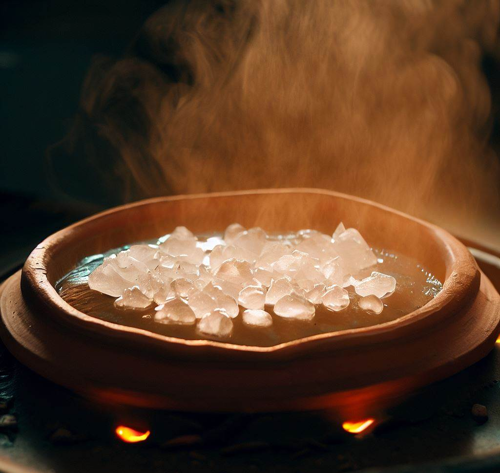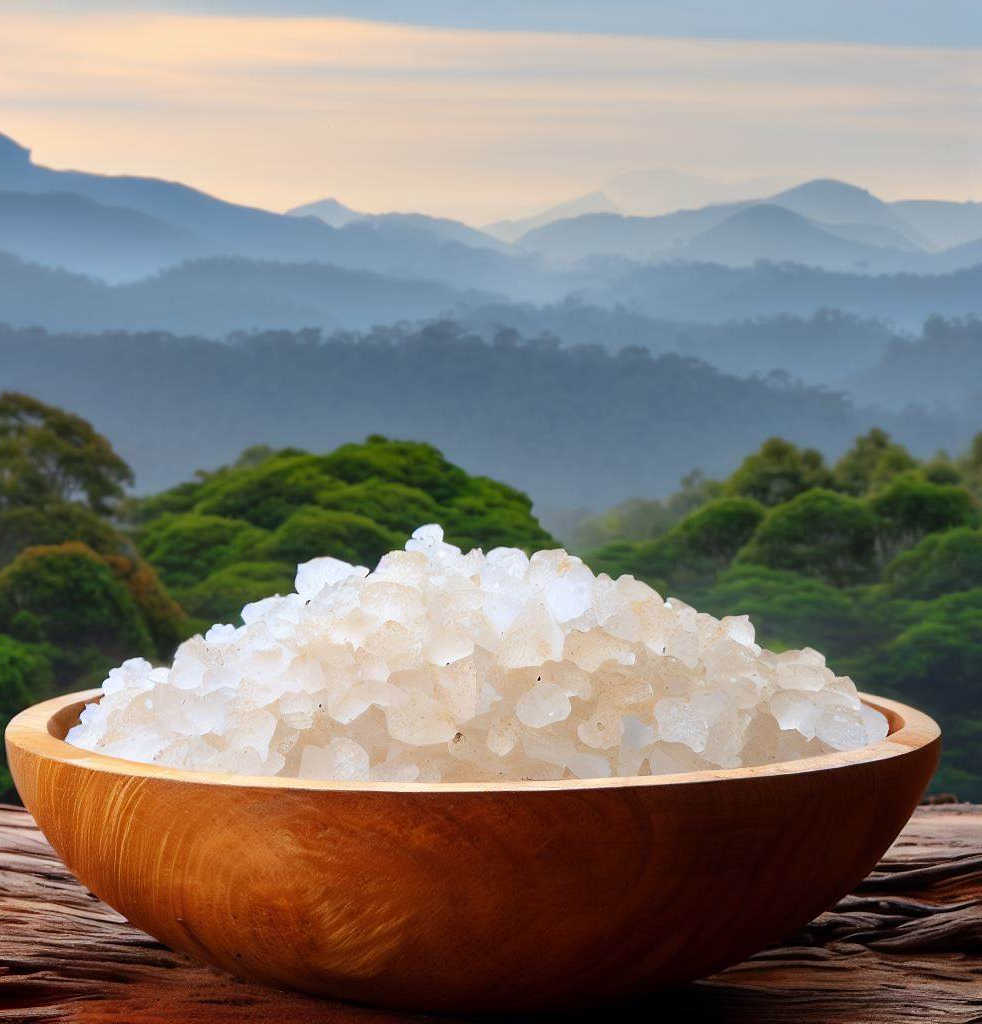Origin and Discovery:
Camphor, scientifically known as Cinnamomum camphora, has a long and intriguing history. It is believed to have originated in Asia, specifically in regions such as India, China, Japan, and Taiwan. The earliest documented use of camphor dates back thousands of years, where it played a significant role in traditional Chinese medicine and Ayurveda, the traditional Indian system of medicine. Camphor is also popular by name Kapur.
While the exact individual who discovered camphor remains unknown, it is likely that its discovery and utilization were gradual, spanning different cultures and civilizations. Its use was well-established in ancient times, indicating a rich history that has been passed down through generations.
Camphor is known by various popular names in different cultures or regions. Here are some examples:
- Indian (Hindi): Kapur (कपूर)
- Indian (Tamil): Pachai Karpooram (பச்சை கற்பூரம்)
- Indian (Malayalam): Karpooram (കറ്പൂരം)
- Chinese: Borneol (冰片, bīng piàn)
- Japanese: Hon-Sho (本草, ほんしょう)
- Indonesian: Kapur Barus
- Thai: Thum (ทับทิม)
- Vietnamese: Bạc Hà (薄荷)
Please note that these names may have variations in different dialects or local languages within each culture or region.
Chemical Composition:
Camphor is a naturally occurring organic compound classified as a terpenoid. Its chemical formula is C₁₀H₁₆O, and it has a molecular weight of 152.23 grams per mole. The compound has a distinctive molecular structure, consisting of a bicyclic monoterpene backbone. This structure is responsible for the unique properties and characteristic aroma of camphor.
There are different types of camphor, including natural camphor, synthetic camphor, and Borneo camphor. Natural camphor is derived from the Cinnamomum camphora tree, primarily through the distillation of the tree's wood and leaves. Synthetic camphor, on the other hand, is chemically produced from turpentine oil or pinene, and its molecular structure is identical to that of natural camphor.
Extraction Process:
The extraction of camphor primarily involves the distillation of the wood, leaves, or roots of the Cinnamomum camphora tree. The tree, commonly known as the camphor tree or camphor laurel, belongs to the Lauraceae family. These trees are native to East Asia but are also cultivated in other parts of the world.
The extraction process begins by obtaining the wood or leaves of the camphor tree. These plant materials undergo a steam distillation process, where they are heated with steam to release the volatile compounds, including camphor. The steam carries the vaporized camphor molecules, which are then cooled and condensed to form solid camphor crystals.
Once the camphor is obtained, it may undergo further refining processes to purify and enhance its quality. This can involve recrystallization, sublimation, or other purification techniques, depending on the desired form and application of the camphor.
It is important to note that while camphor was traditionally extracted from the Cinnamomum camphora tree, modern production methods also involve the synthesis of camphor from other starting materials, such as turpentine oil.
Camphor, with its distinct aromatic properties, has been treasured for centuries due to its numerous benefits. Derived from the Cinnamomum camphora tree, camphor has found its place in various traditional practices, medicinal applications, and spiritual rituals. In this comprehensive guide, we delve into the wide-ranging benefits of camphor, shedding light on its diverse uses and remarkable effects.
Benefits and Uses of Camphor:
-
Historical Significance and Cultural Use:
Camphor holds a rich historical and cultural significance across different civilizations. It has been used in ancient Ayurvedic and Chinese medicine for its healing properties, as well as in spiritual practices and religious ceremonies. Exploring the cultural context of camphor adds depth to understanding its benefits. -
Aromatherapy and Relaxation:
One of the most well-known uses of camphor is in aromatherapy. The invigorating and soothing aroma of camphor has been shown to alleviate stress, anxiety, and mental fatigue. Diffusing camphor oil or using camphor-based products can create a calm and harmonious environment, promoting relaxation and emotional well-being. -
Respiratory Health and Congestion Relief:
Camphor has long been used to relieve respiratory congestion and promote clearer breathing. Its expectorant properties help to break down mucus, making it easier to expel. Inhalation of camphor oil vapors or using camphor-infused balms and rubs can provide relief from cough, cold, sinusitis, and bronchitis symptoms. -
Pain Relief and Anti-inflammatory Effects:
The analgesic and anti-inflammatory properties of camphor make it a popular choice for pain management. Topical application of camphor oil or creams can help alleviate joint pain, muscle soreness, sprains, and minor injuries. Additionally, its cooling sensation provides soothing relief and reduces inflammation. -
Skin Care and Dermatological Benefits:
Camphor offers several benefits for skin health. Its antiseptic and antimicrobial properties make it effective in treating acne, blemishes, and skin infections. Camphor is also known to soothe itching, reduce redness, and provide relief from insect bites. However, caution should be exercised as camphor can be irritating for some individuals and should be used in appropriate dilution. -
Hair and Scalp Benefits:
Camphor has been used to promote healthy hair and scalp for centuries. It helps in combating dandruff, reducing itchiness, and stimulating hair growth. Massaging camphor oil into the scalp can improve blood circulation, strengthening the hair follicles and nourishing the roots. -
Insect Repellent and Pest Control:
The strong fragrance of camphor acts as a natural insect repellent, keeping pests at bay. Placing camphor tablets or using camphor oil in storage areas or closets helps deter moths, mosquitoes, and other insects. It also acts as a deterrent against silverfish and cockroaches. -
Cleaning and Disinfection:
Camphor possesses antimicrobial properties that make it an effective cleaning agent. Adding a few drops of camphor oil to cleaning solutions helps disinfect surfaces, eliminate odors, and maintain a fresh environment. Additionally, camphor-infused cleaning products are eco-friendly alternatives to chemical-based options.
There are different types of camphor available, each with its own characteristics and uses. Here are some of the common types of camphor:
-
Natural Camphor:
- Alternative Names: Gum camphor, Camphor crystals
- Scientific Name: Cinnamomum camphora
- Extraction: Obtained through steam distillation of the wood, leaves, or roots of the Cinnamomum camphora tree.
- Also known as Pachai Karpooram (Tamil), Kacha Karpoor (Hindi)
-
Synthetic Camphor:
- Alternative Names: Artificial camphor
- Extraction: Chemically produced using turpentine oil or pinene as starting materials. It has the same molecular structure as natural camphor.
- Also known as Sarjikarpoor (Hindi), Artifical Karpoor (Hindi)
-
Borneo Camphor:
- Alternative Names: Borneol, Dryobalanops camphora
- Extraction: Obtained from the resin of certain trees native to Borneo and other parts of Southeast Asia.
- Also known as Kapoor Kachli, Bhimseni Kapur (Hindi)
-
D-Camphor:
- Alternative Names: None
- Extraction: Specific stereochemical form of camphor.
- Also known as Kacha Kapur, Chiral Karpoor (Hindi)
-
L-Camphor:
- Alternative Names: None
- Extraction: Another stereochemical form of camphor.
- Also known as L-Karpoor (Scientific/Technical)
BONUS Aromatherapy
Aromatherapy is a popular practice that utilizes the therapeutic properties of various aromatic substances to promote well-being and relaxation. Borneo Camphor, also known as Bhimseni Kapur, is one such substance that can be used effectively in aromatherapy by heating it. Let's explore how you can practice aromatherapy using Borneo Camphor, its benefits, and why it can be a cost-effective alternative to costly essential oils available in the market.

The Process of Aromatherapy with Borneo Camphor/Bhimseni Kapur:
-
Select a Heat-Resistant Container / Diffuser:
Choose a small heat-resistant container or a specially designed camphor heater/burner to perform the aromatherapy process safely. -
Place Borneo Camphor/Bhimseni Kapur:
Take a small piece or a few crystals of Borneo Camphor and place them in the container. Ensure that the container is clean and free from any other substances. -
Heat/Ignite the Camphor:
Use a matchstick or a lighter to ignite the Borneo Camphor. Hold the flame close to the camphor until it catches fire. Once ignited, carefully blow out the flame to let it smolder.
We suggest that if you can arrange a camphor diffuser, it will not produce any soot and enhance your experience. -
Experience the Aroma:
As the Borneo Camphor smolders, it releases a pleasant and distinct aroma. Allow the fragrance to spread in the surrounding area. You can enjoy the aroma by sitting nearby or moving around the space. -
Safety Precautions:
While practicing aromatherapy with Borneo Camphor, ensure proper ventilation in the room. Avoid direct inhalation of the smoke and place the container on a heat-resistant surface to prevent any accidents. Keep it away from the reach of children and pets.
Benefits of Aromatherapy with Borneo Camphor/Bhimseni Kapur:
-
Relaxation and Stress Relief:
The aroma of Borneo Camphor can help induce a sense of relaxation, ease tension, and alleviate stress. It creates a soothing atmosphere that promotes calmness and mental well-being. -
Respiratory Health:
The inhalation of Borneo Camphor's aroma may provide respiratory benefits by helping to clear congestion, relieve coughs, and promote easier breathing. It is often used during colds, coughs, or sinus-related discomfort. -
Mental Clarity and Focus:
The fragrance of Borneo Camphor has invigorating properties that can help enhance mental clarity, concentration, and focus. It is particularly beneficial during times when you need to stay alert and focused. -
Mosquito Repellent:
Borneo Camphor has natural insect-repellent properties, making it an excellent choice for keeping mosquitoes and other insects at bay. It can be especially useful during outdoor activities or in areas prone to mosquito infestation.
Why Borneo Camphor/Bhimseni Kapur is a Cost-Effective Alternative:
-
Affordability:
Borneo Camphor is generally more affordable compared to many costly essential oils available in the market. It provides a cost-effective option for those seeking aromatherapy benefits without breaking the bank. -
Versatility:
Borneo Camphor offers a wide range of benefits, making it a versatile choice for aromatherapy. It can be used for relaxation, respiratory health, mental clarity, and insect repellent purposes, providing multiple benefits in a single substance. -
Long-Lasting Aroma:
Borneo Camphor has a long-lasting aroma that can continue to fill the air even after the smoldering process is completed. You can enjoy its fragrance for an extended period, reducing the need for frequent reapplications. -
Cultural and Traditional Significance
Conclusion:
Camphor, with its captivating aroma and remarkable properties, continues to enthrall us with its versatility and multifaceted benefits. From its historical and cultural significance to its wide range of applications in healthcare, spirituality, and daily life, camphor remains a natural wonder worth exploring. However, it is
Discover More
Most Viewed
Christmas is a season of joy, love, and traditions. And what better way to get into the holiday spirit than through timeless carols? These musical gems have been bringing people together for generations. Here’s our ranked list of the Top 10 Christmas Caro…
Read More
















